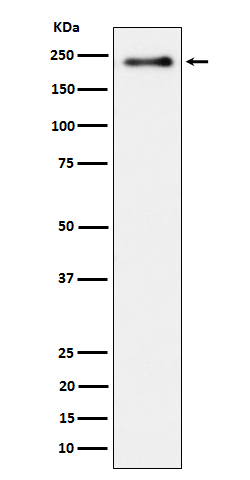Phospho-LRP6 (S1490) Antibody
Rabbit mAb
- SPECIFICATION
- CITATIONS
- PROTOCOLS
- BACKGROUND

Application
| WB |
|---|---|
| Primary Accession | O75581 |
| Clonality | Monoclonal |
| Other Names | Low-density lipoprotein receptor-related protein 7; |
| Isotype | Rabbit IgG |
| Host | Rabbit |
| Calculated MW | 180429 Da |
| Dilution | WB 1:500~1:2000 |
|---|---|
| Purification | Affinity-chromatography |
| Immunogen | A synthesized peptide derived from human Phospho-LRP6 (S1490) |
| Description | Acts as a coreceptor with members of the frizzled family of seven-transmembrane spanning receptors to transduce signal by Wnt proteins (PubMed:11336703, PubMed:11448771, PubMed:15778503, PubMed:11719191, PubMed:15908424, PubMed:16252235). |
| Storage Condition and Buffer | Rabbit IgG in phosphate buffered saline , pH 7.4, 150mM NaCl, 0.02% sodium azide and 50% glycerol. Store at +4°C short term. Store at -20°C long term. Avoid freeze / thaw cycle. |
| Name | LRP6 |
|---|---|
| Function | Component of the Wnt-Fzd-LRP5-LRP6 complex that triggers beta-catenin signaling through inducing aggregation of receptor-ligand complexes into ribosome-sized signalosomes (PubMed:11357136, PubMed:11448771, PubMed:15778503, PubMed:16341017, PubMed:16513652, PubMed:17326769, PubMed:17400545, PubMed:19107203, PubMed:19293931, PubMed:19801552, PubMed:28341812). Cell-surface coreceptor of Wnt/beta- catenin signaling, which plays a pivotal role in bone formation (PubMed:11357136, PubMed:11448771, PubMed:15778503, PubMed:16341017, PubMed:16513652, PubMed:17326769, PubMed:17400545, PubMed:19107203, PubMed:19293931, PubMed:19801552, PubMed:28341812). The Wnt-induced Fzd/LRP6 coreceptor complex recruits DVL1 polymers to the plasma membrane which, in turn, recruits the AXIN1/GSK3B-complex to the cell surface promoting the formation of signalosomes and inhibiting AXIN1/GSK3-mediated phosphorylation and destruction of beta-catenin (PubMed:16513652). Required for posterior patterning of the epiblast during gastrulation (By similarity). |
| Cellular Location | Cell membrane; Single-pass type I membrane protein Endoplasmic reticulum. Membrane raft. Note=On Wnt signaling, undergoes a cycle of caveolin- or clathrin-mediated endocytosis and plasma membrane location. Released from the endoplasmic reticulum on palmitoylation Mono-ubiquitination retains it in the endoplasmic reticulum in the absence of palmitoylation. On Wnt signaling, phosphorylated, aggregates and colocalizes with AXIN1 and GSK3B at the plasma membrane in LRP6- signalosomes (By similarity). Chaperoned to the plasma membrane by HSP90B1 and MESD (PubMed:23572575). {ECO:0000250|UniProtKB:O88572, ECO:0000269|PubMed:23572575} |
| Tissue Location | Widely coexpressed with LRP5 during embryogenesis and in adult tissues |

Thousands of laboratories across the world have published research that depended on the performance of antibodies from Abcepta to advance their research. Check out links to articles that cite our products in major peer-reviewed journals, organized by research category.
info@abcepta.com, and receive a free "I Love Antibodies" mug.
Provided below are standard protocols that you may find useful for product applications.
If you have used an Abcepta product and would like to share how it has performed, please click on the "Submit Review" button and provide the requested information. Our staff will examine and post your review and contact you if needed.
If you have any additional inquiries please email technical services at tech@abcepta.com.













 Foundational characteristics of cancer include proliferation, angiogenesis, migration, evasion of apoptosis, and cellular immortality. Find key markers for these cellular processes and antibodies to detect them.
Foundational characteristics of cancer include proliferation, angiogenesis, migration, evasion of apoptosis, and cellular immortality. Find key markers for these cellular processes and antibodies to detect them. The SUMOplot™ Analysis Program predicts and scores sumoylation sites in your protein. SUMOylation is a post-translational modification involved in various cellular processes, such as nuclear-cytosolic transport, transcriptional regulation, apoptosis, protein stability, response to stress, and progression through the cell cycle.
The SUMOplot™ Analysis Program predicts and scores sumoylation sites in your protein. SUMOylation is a post-translational modification involved in various cellular processes, such as nuclear-cytosolic transport, transcriptional regulation, apoptosis, protein stability, response to stress, and progression through the cell cycle. The Autophagy Receptor Motif Plotter predicts and scores autophagy receptor binding sites in your protein. Identifying proteins connected to this pathway is critical to understanding the role of autophagy in physiological as well as pathological processes such as development, differentiation, neurodegenerative diseases, stress, infection, and cancer.
The Autophagy Receptor Motif Plotter predicts and scores autophagy receptor binding sites in your protein. Identifying proteins connected to this pathway is critical to understanding the role of autophagy in physiological as well as pathological processes such as development, differentiation, neurodegenerative diseases, stress, infection, and cancer.


